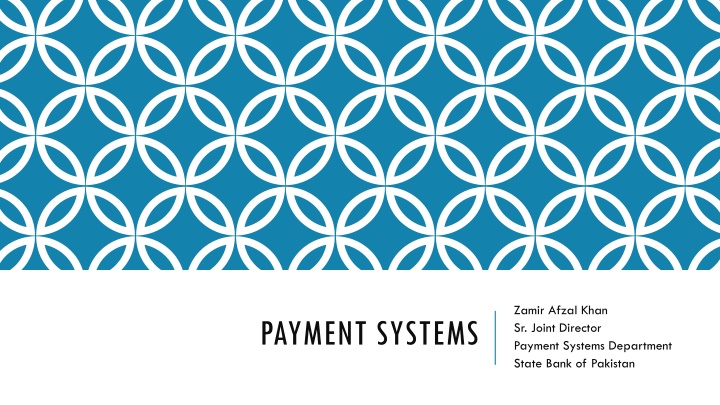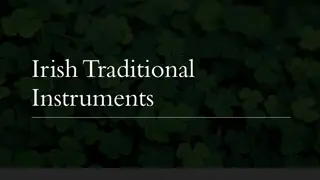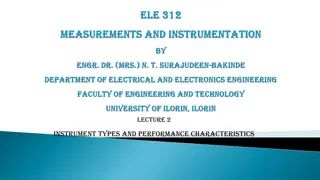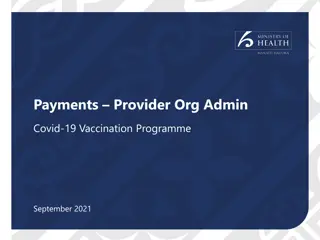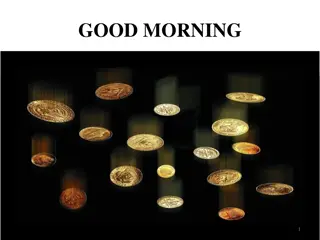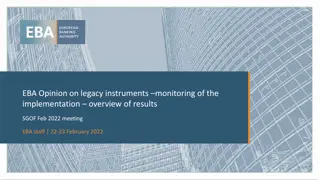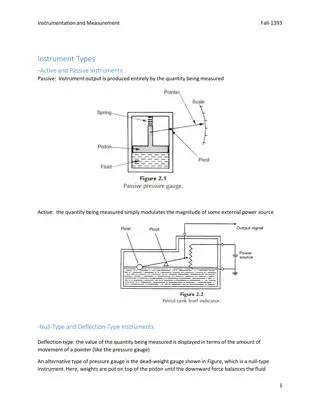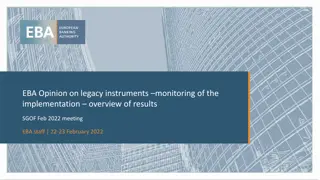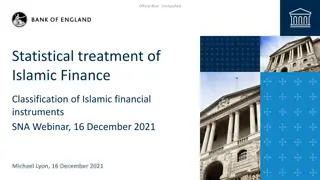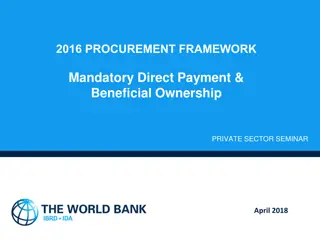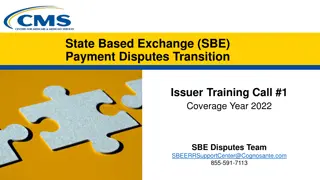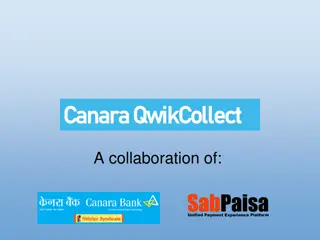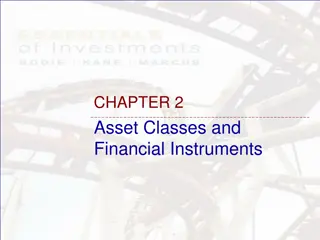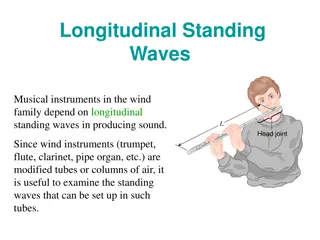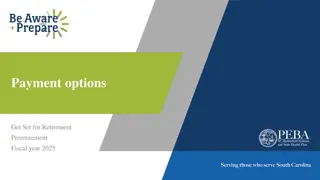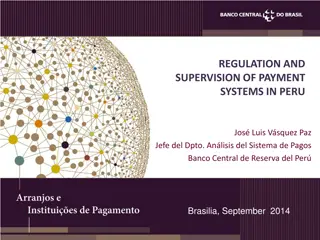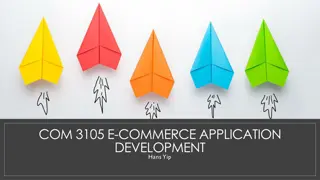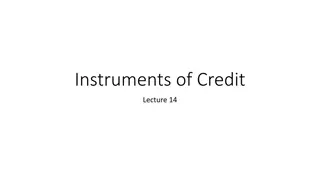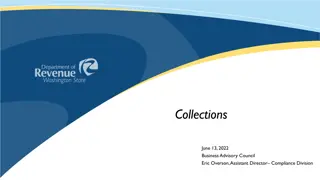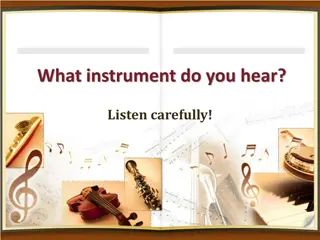Overview of Payment Systems and Instruments
Explore the world of payment systems, instruments, and their relationships in the financial market. Understand the characteristics of payment instruments, such as cash, cards, credit transfers, and digital currencies. Dive into the security features of payment cards and the technology behind fraud protection. Gain insights into regulatory objectives and frameworks governing payment systems. Uncover the dynamics of trade reporting systems, delivery systems, and interbank fund transfers within the payment ecosystem.
Download Presentation

Please find below an Image/Link to download the presentation.
The content on the website is provided AS IS for your information and personal use only. It may not be sold, licensed, or shared on other websites without obtaining consent from the author.If you encounter any issues during the download, it is possible that the publisher has removed the file from their server.
You are allowed to download the files provided on this website for personal or commercial use, subject to the condition that they are used lawfully. All files are the property of their respective owners.
The content on the website is provided AS IS for your information and personal use only. It may not be sold, licensed, or shared on other websites without obtaining consent from the author.
E N D
Presentation Transcript
Zamir Afzal Khan Sr. Joint Director Payment Systems Department State Bank of Pakistan PAYMENT SYSTEMS
AGENDA Understanding Payment Systems Payment Instruments Clearing Settlements Regulatory Objectives Regulatory Framework Initiatives
PAYMENT SYSTEMS Definition A set of instruments, procedures, and rules for the transfer of funds between or among participants; within a geographical boundary. The system includes the participants and the entity operating the arrangement e.g. retail payment system and LVPS Markets Retail and Wholesale Capital and Commodity Money FX
RELATIONSHIP (MARKET & INFRA) Retail Whole Sale (Corporate) Foreign Exchange Market Commodity Market Capital Market Money Market Trading Delivery Deal Making Buyer Seller Deal Completion Payment Market Related Trade Reporting System(s) Delivery Systems (Ownership Transfer like CDC etc) Source: NPS South Africa Payment Systems 4
RELATIONSHIP (MARKET & INFRA) Trade Reporting Systems KATS Reuters Delivery Systems CDC PRISM (securities) Payment & Settlement Systems Cheque Clearing Systems Interbank Fund Transfers PRISM (RTGS) System
PAYMENT INSTRUMENTS Cash Cards Credit Transfers (IBFT, RTGS, SWIFT) Cheques Digital Currencies (BitCoin)
CHARACTERISTICS OF PAYMENT INSTRUMENTS Push Instrument Credit Transfers, No Credit Risk Less Complicated Pull Instrument Cheques, Cards Credit Risk More Complicated Push Instrument are preferred choice for digital payments
PAYMENT CARDS Cards (Credit Card, Debit Card, Prepaid Cards) Participants Customer Merchant Issuing Bank Acquiring Bank Payment Schemes Transaction Types Card Present Card Not Present
PAYMENT CARD SECURITY Fraud protection and data security EMV chip: Technology that uses secret cryptographic keys to help protect against fraud at the point of sale and make payment cards more difficult to counterfeit. 3-D Secure is an XML-based protocol designed to be an additional security layer for online credit and debit card transactions PCI Security Standards: Security controls for making sure that customer's card data is kept secure throughout the entire transaction process.
PAYMENT CARDS For FY 2017-18 (for period 01-Jul-17 to 30-Jun-18) Credit Cards Debit, ATM only, Prepaid and Social Welfare Cards POS Terminals Credit Card Issuers Debit Card Issuers Debit Card Transactions - Volume Debit Card Transactions - Value Credit Card Transactions - Volume Credit Card Transactions - Value POS Acquirers POS per 100,000 Population 1,453,867 39,465,126 53,511 12 31 438.4 million 5075.9 billion 35.4 million 201.5 billion 9 26
CREDIT TRANSFERS IBFT (1-Link) For retail payments Enables banks to offer Inter Bank Fund Transfers using ATMS, Internet Banking and Call Centers Charges determined by the banks individually. PRISM Transfers (SBP) For Large Value Payment Credit transfers through bank branches Charges determined by SBP
CHEQUE CLEARING 1. A SENDS CHECK TO B CUSTOMER A OF MCB CUSTOMER B OF CITIBANK PAY B Rs 100 2. B DEPOSITS CHECK AT CITI 7. CLEARING HOUSE SENDS CHECK TO MCB CITIBANK MCB BANK 4. CITI SENDS CHECK TO CLEARING HOUSE CUSTOMER A CUSTOMER B . . . B CUSTOMER Z CUSTOMER C CUSTOMER A . . . CUSTOMER Y CUSTOMER Z -100 CLEARING HOUSE (NIFT) +100 -100 MCB BANK A . . . BANK Z CITIBANK 3. CITIBANK CREDITS B WITH Rs 100 8. MCB DEDUCTS Rs 100 FROM A ACCOUNT 6. CLEARING HOUSE SENDS MCB DEBIT INFO +100 5. CLEARING HOUSE ADDS Rs 100 TO CITI, SUBTRACTS Rs 100 FROM MCB 12
CLEARING-PAPER INSTRUMENTS Clearing Procedure From banks to clearing house to banks Clearing Batches Same day, Normal & Intercity Clearing House (NIFT) More than 28 offices & Hubs Processing of cheques based on MICR using sorters Preparation of Clearing Batches Submission of Clearing Batches
CLEARING Clearing Infrastructure is required to process payment instruments settlement between different financial institutions and their customers E.g. Cheques drawn on other banks, credit transfers sent to other banks customer Clearing can be physical, automated or electronic Major clearing institutions in Pakistan (NIFT, 1-Link, NCCPL) The process of transmitting, reconciling and, in some cases, confirming payment orders or security transfer instructions prior to settlement, possibly including the netting of instructions and the establishment of final positions for settlement. Sometimes the term is used (imprecisely) to include settlement. (BIS)
CLEARING METHODS Bilateral Settlements Between two financial institutions. Typically used FX transactions Low risk but inefficient for retail payments Multilateral Net Net settlement between multiple institutions. Used for retail payment Efficient Settlement but high risk as any participants default can result in systemic risk Done by clearing houses like NIFT and 1-Link etc.
BI LATERAL NETTING A-B=25 75 Bank A Bank B 100 Payment Obligations 75 25 85 30 90 C-A=50 D-B =55 85 Bank C Bank D 45 16
Funds Transfers Under Bilateral Clearing 25 Bank B Bank A 90 50 (75-25) 55 (85- 30) Bank C Bank D 30 17
Funds Transfers Under Multilateral Clearing Bank B Bank A 140 240 Clearinghouse 10 90 Bank C Bank D 18
SETTLEMENT The completion of transaction or of processing with the aim of discharging participants obligations through the transfer of funds and/or securities. Settlement methods can be Gross or Net. Gross Settlement used for Wholesale payments. Requires more liquidity but less risky Net Settlement used for retail payment. More risk but requires less liquidity. Wholesale Payment Systems such as PRISM settles on Real Time Gross Settlement (RTGS) basis.
TRADING AND PAYMENT (DISTINCTION) Source NPS: South Africa
PAYMENT SYSTEM &ECONOMY Real Economy and Financial Markets Purchase and Sale of goods and services Banking System Provision of Payment Services IBFT Clearing and Settlement Processes Central Bank Source NPS: South Africa
REGULATORY OBJECTIVES Safety and Efficiency in Payment Systems Payment Instruments, Alternate Delivery Channels, Clearing Houses, Payment Systems Operators and Payment Service Providers, Financial Institutions. Risks Legal, Liquidity, Credit, Settlement, Custody, Agent, FX Settlement Implementation Powers Legal Powers under BCO 1962 and PS&EFT Act 2007
REGULATORY FOCUS Payment Systems Payment Instrument Alternate Delivery Channels Clearing Houses Payment Schemes Payment System Operators Payment Service Providers
PAYMENT CARD SECURITY Payment Cards security Regulations (2016) Milestones Acquiring Infrastructure Compliance Dec 31, 2017 Issuing of EMV compliant Cards Jun 30, 2018 Chip and PIN Dec 31, 2018 Challenges Availability of Vendors (TPS and Avanza) Inadequate testing facilities and certification slots Capital Intensive (Hardware, Middleware, Development costs etc.)
REGULATORY FRAMEWORK Electronic Fund Transfer Rules Payment Message Transparency and standardization by routing originator and beneficiary information Name of the Originator, beneficiary Name of the Beneficiary Originator s IBAN / Mobile Account Number (if applicable) Originating AFI Name, Beneficiary AFI Name Transaction reference number Amount of transaction Responsibilities of originating and beneficiary financial institutions and PSOs/PSPSs Compensation policy
REGULATORY FRAMEWORK Internet Banking Security Regulations (2015) Risk Management framework Minimum set of operational, administrative, technical and physical safeguards to secure Internet Banking offered Two Factor Authentication Clearing Guidelines Fixing responsibilities of each participants in Clearing Cycle Centralized Intercity Clearing Clearing Operations in Remote Areas and its settlement through RTGS on bilateral basis Compensation for Delayed Payments Standardized Return codes
DIGITAL PAYMENTS SECURITY CIRCULAR Vulnerability assessment and penetration testing of systems Setting bank-wise limits with international payment schemes. Activation of any internet banking after biometrics Deployment of fraud monitoring systems, use of threat intelligence Customers to activate or block their cards for online/cross-border transactions Free of cost SMS transaction alerts Bank/MFB to compensate customers within two (02) business days Banks to issue chip and pin cards, pin authentication for e-commerce transaction,
NEW INITIATIVES Guidelines for White Label ATM Operators Allow non banks to own and operate ATMs Pricing based on consumer consent EMI Regulations Allow non banks to hold consumer money for the purpose of payments Credit product is not allowed the amount taken by EMI shall not be treated as depots Customer Due diligence Transactions limits licensing Criteria oversight and supervision
INFRASTRUCTURE INITIATIVES Automated Transfer Systems Automated Clearing House Bulk Transfers Delivery Vs Payment Settlement Payment Vs Payment Settlement International Messaging Standards Micro Payment Gateway Focus on Micro Payments and Financial Inclusion Instant Retail Payments
